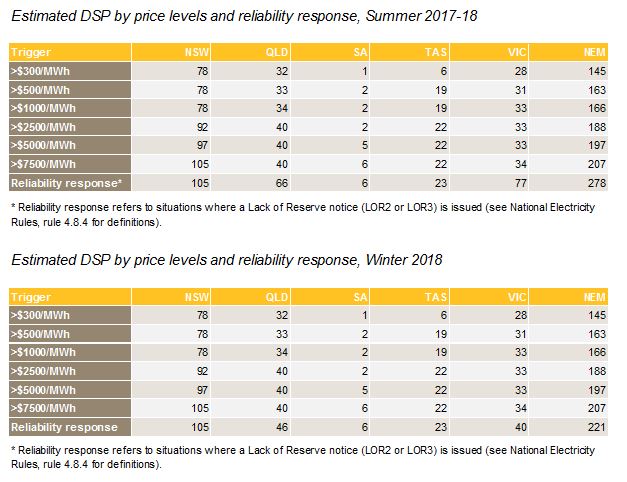Demand side participation
Demand side participation (DSP) reflects the capability of demand side resources (customer load reductions or generation from customers’ embedded generators) to reduce operational demand at times of high wholesale prices or emerging reliability issues.
DSP captures direct response by industrial users, and consumer response through programs run by retailers, DSP aggregators, or network service providers.
AEMO has updated its estimate of current DSP in the NEM, based on new data on loads providing DSP obtained late 2017. This allowed AEMO to improve the estimate, by estimating all DSP based on historical performance (previously, this historical information was only used for estimating larger industrial load DSP).
The estimated level of DSP available for summer 2017-18 and winter 2018 is shown in the tables below. It reflects the observed 50% probability of exceedance DSP resource response to different wholesale price levels in recent years. Actual responses vary significantly from occasion to occasion.
Reliability response DSP estimates are also included, referring to situations where additional DSP is observed in response to a Lack of Reserve notice (LOR2 or LOR3) being issued (see National Electricity Rules, rule 4.8.4 for definitions).
Values in the tables are cumulative. For example, the table shows the estimated price response is 34 megawatts (MW) for Queensland when prices exceed $1,000 a megawatt hour (MWh), and 40 MW when prices exceed $2,500/MWh. However, if a LOR2 or LOR3 is declared, the total DSP response is estimated to be 66 MW in Queensland, should it occur during summer.
The capacities listed exclude any DSP procured through the Reliability and Emergency Reserve Trader (RERT) process, including the joint DSP program by ARENA and AEMO.

The updated reliability response estimate of 278 MW across the NEM regions is lower than the 2017 Electricity Forecasting Insights estimate of 512 MW during summer 2017-18. The key reason for this is a change in methodology for assessing the reliability response to better reflect the uncertainty in actual response at any point in time. The 2017 DSP estimate was based on an assumption that almost all potential DSP would respond during LOR2 or LOR3 conditions, however this is inconsistent with historical observations and risks overstating the DSP contribution in AEMO’s reliability assessments. Therefore, the updated estimate is more conservatively based on the 50% probability of exceedance response observed at prices above $7,500 a MWh plus response from network reliability programs.
Future DSP
The estimated DSP capability in the tables above is used for reliability assessments, such as Medium Term Projected Assessment of System Adequacy (MT-PASA) and the Electricity Statement of Opportunities (ESOO).
AEMO will forecast possible growth in DSP as part of its Integrated System Plan to be published mid-2018.






